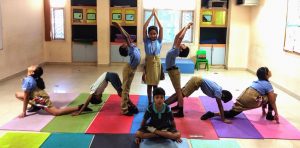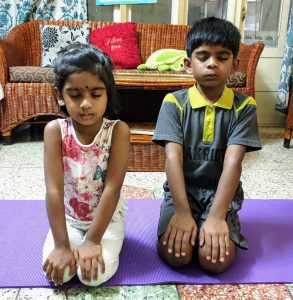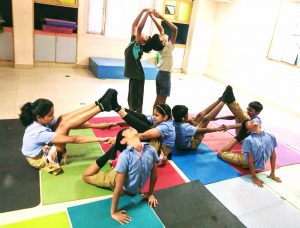This article explains the relevance of yoga in a child’s education, and how it aligns with PYP philosophy and practice.
When practised every day, yoga not only benefits children physically, but also plays an important role in the ongoing development of wellbeing and mental health.
Yoga offers a holistic fitness array of Asanas, Pranayama and Meditation.
In a child’s language, it helps counter the stress during the bustling pace of the child’s life.
When children learn techniques for self-health, relaxation, and inner fulfilment, they are able to navigate daily challenges with more ease. Yoga at an early age encourages body awareness and self-esteem along with physical activity that is non-competitive in nature.
Yoga integrates very well into the PYP as it emphasises one of the strands of self-management skills – States of Mind. Regular practice of yoga helps with managing the state of mind as it develops mindfulness (by being aware of body-mind connections). Asanas like Matsyasana (Fish Pose) help reduce stress and anxiety thereby promoting emotional management. Apart from this, yoga enhances flexibility, strength, coordination and concentration. Students can build resilience while developing their personality that helps them respect the world around them, and thus be compassionate.
At our school, Yoga is a part of PSPE owing to the fact that it develops the overall wellbeing of the student. It touches on two of the PSPE strands – Identity and Active living. A student is able to recognize their strengths, limitations and challenges, thereby promoting healthy habits.
During my classes, when children practice poses like Vrschikasana (scorpion pose), Hamsasana (swan pose) and Shashankasana (rabbit pose), they are able to connect to the world around them, draw inspiration from these animals poses and imbibe their innate qualities- being as graceful as a swan, alert as a scorpion and as calm as a rabbit. Simhasana (lion pose) on the other hand helps them connect with their inner thoughts and learn when to be assertive and when to retreat.
Bringing in an element of fun though activities, helps sustain student attention and interest. For example, during the ‘Jungle Book Activity’ inspired by ‘The Jungle Book’ (written by Rudyard Kipling in 1894), children jumped at the chance of assuming the role of the characters in that book and immediately worked on a role play involving their group members effectively.
The effect of Music on Yoga
Music has many effects on our mind, body, mood and wellbeing. Consciously or unconsciously we are affected by the sounds we hear. For example, a driving beat can excite the senses and push us emotionally into motion. Alternately, soothing sounds or a slow mantra eases the mind and relaxes the body, letting the mind’s eye turn inward.
After introducing music to my Yoga classes, I have realised that it sets the emotional tone of the class. Students have reflected that it helps them let out their mental chatter, and make peace with themselves as it soothes and relaxes their mind.
Creativity in Yoga
Creativity is not only restricted to the arts, but can be extended to any subject, even Yoga. When asked to come up with creative ideas for showcasing Yoga, students have integrated several poses and created their own formations with their peer or in groups. This is a great example of creativity and peer interaction and connects well with the attributes of the learner profile.
School Connect and Skype sessions help students expand their horizons and learn from people all over the world. A Skype session with a yoga instructor from Qatar gave students of Grade 4 an opportunity to learn simple poses like Shashankasana and Bhujangasana. The students of Grade 5 are looking forward to connecting with the students of Groupe Scolaire Carlepont, in France, where our students will don the hat of a teacher and teach them some basic yoga poses.
Action is a major part of the PYP curriculum and our yoga students have taken that to heart and taught their siblings and parents some poses that they learnt and thought would be beneficial for the whole family.
Mindfulness through Yoga
Stressful events in childhood can increase the risk of developing health problems as an adult, but the impact may hit much earlier. It can affect a child’s health and well-being almost immediately, and can contribute to the development of physical and mental health problems and learning disabilities. Teaching mindfulness can help reverse the impact that stress can have on the individual. I believe that Yoga can be a beneficial tool in bringing mindfulness into the lives of the young minds and contribute to reducing stress, improve sleep quality and heightened focus. Learning mindfulness practices, including meditation, breathing exercises, yogasanas (postures) and chanting can have a significant long-term effect on a child’s overall development. Yoga is an excellent tool that helps students enhance their memory and provides them with energy and power.
“Yoga is a light, which once lit, will never dim. The better your practice, the brighter the flame.” B.K.S Iyengar
“Yoga is a light, which once lit, will never dim. The better your practice, the brighter the flame.” B.K.S Iyengar
About the author:
Seema Shetty is PYP Yoga facilitator at Oakridge International School, Newton Campus, an IB continuum school.
A certified Yoga Instructor, Seema is passionate about bringing innovation, excitement and imagination into every yoga class.







No comments yet.